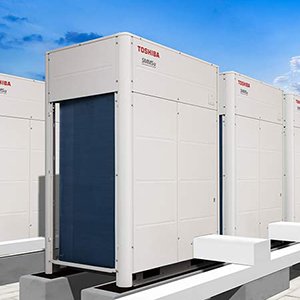Variable Refrigerant Flow (VRF): VRF systems use variable-speed compressors that can adjust the refrigerant flow to meet the specific requirements of each indoor unit. This allows for more precise temperature control and energy efficiency.
Modular Design: VRF systems consist of outdoor units and multiple indoor units connected by refrigerant piping. The modular design makes them suitable for a wide range of applications, from small offices to large commercial buildings.
Zoning Capability: One of the main advantages of VRF systems is their ability to provide individualized control over the temperature in different zones or rooms. This zoning capability allows for energy savings by only conditioning spaces that are in use.
Heat Recovery and Heat Pump Models: Toshiba offers both heat recovery and heat pump VRF systems. Heat recovery systems can simultaneously provide heating and cooling to different zones within a building, while heat pump systems are designed for either heating or cooling in each zone.
Energy Efficiency: VRF systems are known for their energy efficiency due to the variable-speed compressors and the ability to recover heat from one zone for use in another. This can result in significant energy savings compared to traditional HVAC systems.
Control and Monitoring: Toshiba VRF systems often come with advanced control and monitoring capabilities. Users can control the system remotely, set schedules, and monitor performance for optimal efficiency.
Quiet Operation: Toshiba VRF systems are designed to operate quietly, making them suitable for various applications, including residential settings where noise levels are a concern.
Integration with Building Management Systems (BMS): These systems can often be integrated with BMS, allowing for centralized control and monitoring of multiple building systems.

Toshiba VRF systems offer precise temperature control, energy efficiency, and the ability to heat and cool different zones simultaneously, unlike traditional systems.
Benefits include energy efficiency, individualized zone control, quiet operation, and the ability to recover heat for increased efficiency.
Yes, Toshiba VRF systems are available in both heat pump and heat recovery models, allowing for heating and cooling as needed.
Toshiba VRF is versatile and suitable for various applications, including residential homes, offices, hotels, hospitals, and large commercial buildings.
Zoning allows for different temperature settings in various zones or rooms, optimizing energy usage and providing personalized comfort.
Professional installation is recommended. Toshiba VRF systems require careful design and installation to ensure optimal performance.
Yes, many Toshiba VRF systems feature advanced controls, including remote access for convenient monitoring and adjustment.
Regular maintenance is essential for peak performance. It includes cleaning filters, checking refrigerant levels, and inspecting system components.
Visit the official Toshiba website or contact Toshiba customer support to find authorized dealers and service centers in your area.









